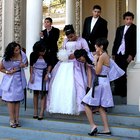
Traditional weddings in Mexico are full of customs and rituals that are steeped in Mexican history and the beliefs of the Roman Catholic Church. Many traditions still practiced in Mexican weddings date back as far as seven centuries. These traditions are rich in symbolism, and include a mix of prayer and festivity. Mexican weddings are almost always held in a Catholic church, and the couple are considered married for eternity. From the ceremony to the mariachi music in the ending procession, Mexican weddings are beautiful celebrations of love.
Padrinos
Like other weddings around the world, Mexican weddings can be expensive. The wedding couple gets financial help from their godparents, known as padrinos. The padrinos are given a place of honor near the wedding couple during the ceremony. Sometimes they give the wedding couple a gift of a Bible and rosary. In addition to financial sponsorship, the padrinos act as mentors before the wedding and afterward in the young marriage.
Lazo
The wedding lazo, also known as lasso, is part of all Mexican weddings. This symbolic cord represents the commitment and love the couple has promised each other. After the vows are said, attendants or the godparents place the lazo in a figure-eight pattern around the groom's neck and then the bride's, to show they are linked together in marriage for eternity. Instead of a cord, a large rosary is sometimes used. After the wedding, the bride takes the lazo as a keepsake.
Arras Gift
Another symbolic gesture is the gift of Arras to the bride from her groom. Arras are 13 gold coins that have been blessed by the priest. One coin represents Jesus Christ, and the remaining 12 represent his apostles. Furthermore, it is a declaration of love and a promise from the groom that he will provide well for his bride. Her acceptance of the coins is symbolic of her trust and faith in his promise.
Guayabera and Huipil
The guayabera is the traditional wedding shirt worn by the groom. The shirt style is about 200 years old. It is a very detailed shirt, which includes embroidered panels or pleats sewn close together vertically. The design covers both the front and back. Commonly worn with a tuxedo in a church ceremony, it is also the shirt of choice for Mexican beach weddings. Aside from the traditional aspect of wearing the guayabera, its loose fit makes it comfortable when worn on the hot Mexican beach. A popular color is white, but other colors can be worn at less formal weddings.
The bride's dress is similar to traditional wedding dresses in the U.S. The difference is that the sleeves are always short, and the wedding dress, like the guayabera, is very detailed, with flowers or shapes embroidered by hand. This style of Mexican wedding dress is called a huipil.
Music
Many believe that a traditional Mexican wedding is not complete without a mariachi band playing the music. The members of a mariachi band, in general, play guitars, drums and trumpets. There are sometimes harps and violins, as well. The bands often dress as cowboys, since mariachi music is a style of Mexican ranch music. For weddings, they may dress in black and silver or white instead. When performing at weddings, mariachis add a festive air to the reception. It is also customary for the band to play as part of the wedding procession when the wedding is ending.
Related Articles

Mexican Catholic Wedding Traditions

Traditional Chilean Wedding Attire

A Guide to Preparation for a Hindu ...

Romanian Orthodox Wedding Traditions

The Difference Between a Corsage & ...

Prayer Shawls at Jewish Weddings

How to Tie a Love Knot for Wedding ...

The Customs of Traditional Spanish ...

The Meaning of Wedding Bands

What Does the Corsage Symbolize?

Mexican Quinceanera Traditions

Malay Traditional Wedding Attire

What Do Chinese Women Wear?

The History of the Boutonniere

Traditional Korean Wedding Gifts

Hispanic Clothing History

What Is the Jaan Arrival in an Indian ...

The Meaning of a Single White Rose

The Purpose of Christening

What Is the Godparents' Responsibility ...
References
Writer Bio
Connie Whiting has been a professional writer since 1999. She is published in Red Rock Press Anthologies and "Legacy" magazine. She is also an experienced food column writer. Past positions include certified dental assistant and virtual assistant for “Your Invisible Assistant” a service focused on travel arrangements and media writing. Currently, Connie writes for Demand Studios while pursuing an Associate of Arts.
Photo Credits
Jupiterimages/Polka Dot/Getty Images